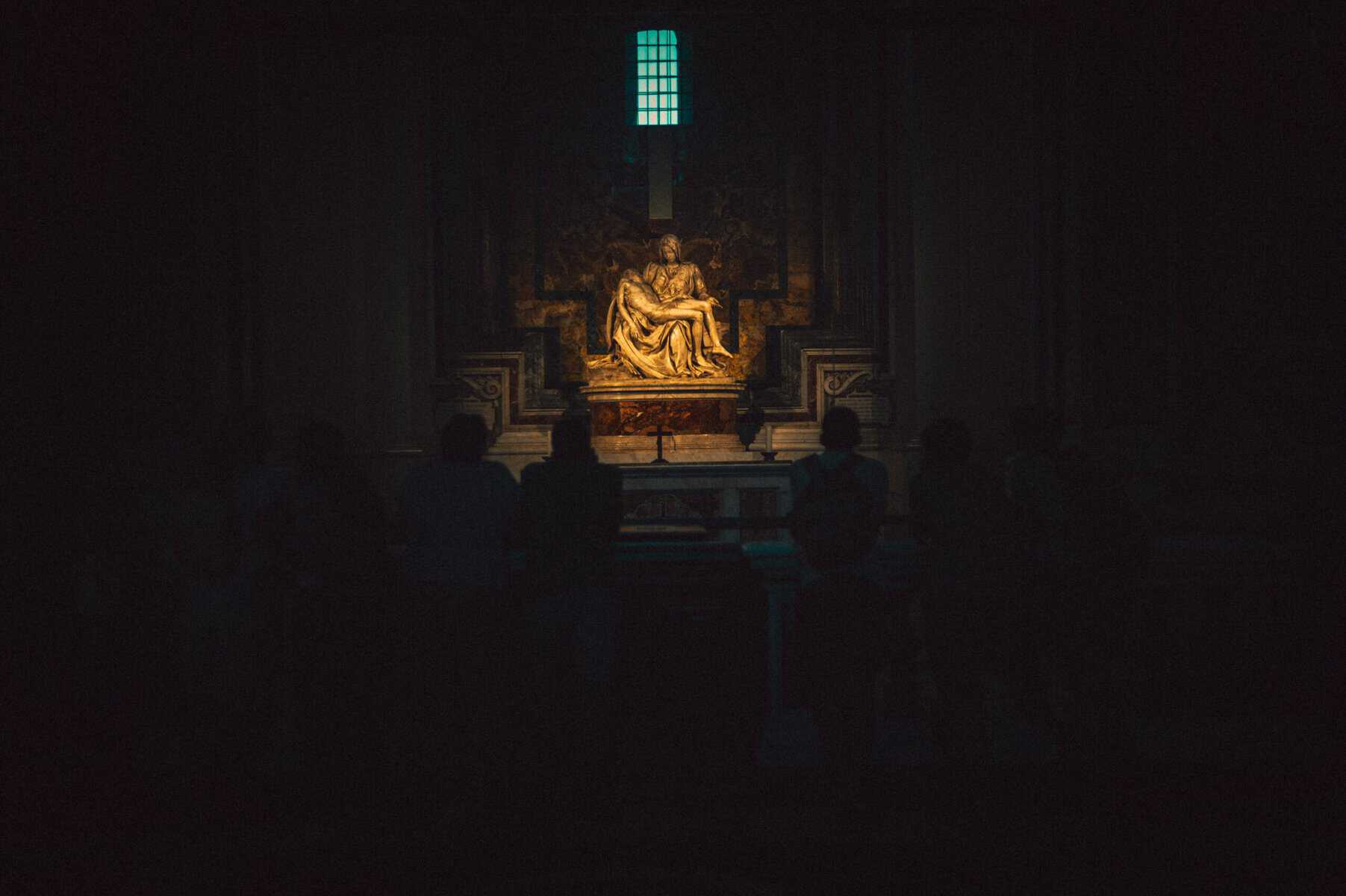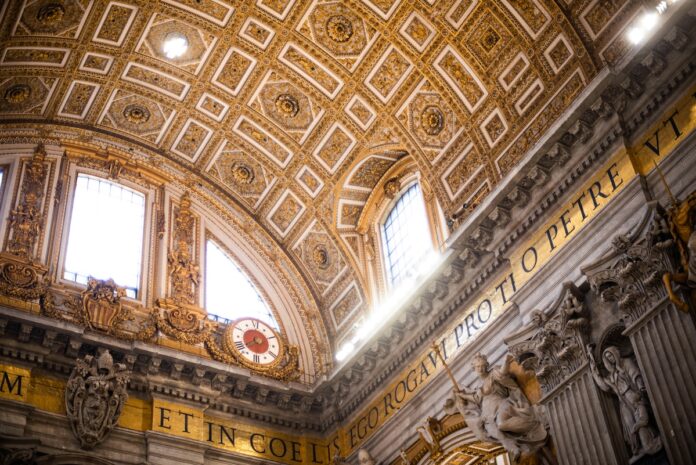By Father Jeffrey Kirby/National Catholic Register
One of the most identifiable places of worship on planet Earth is St. Peter’s Basilica on the Vatican Hill in Rome. It is the sanctuary and resting place of the chief apostle of Jesus Christ, Simon Peter of Galilee, the first pope of the Christian faith.
The current basilica is the second house of worship to sit on its current site. The first basilica was built by the Emperor Constantine in the mid-fourth century, as the Christian faith was legalized after centuries of persecution. Due to age and neglect, the first basilica was torn down and the second was constructed. The second and current basilica was built during the Italian Renaissance, and it serves as the crown of that artistic and cultural movement; it was consecrated on Nov. 18, 1626. As such, nothing can compete with the size, majesty and power of St. Peter’s Basilica. It reflects the best of humanity’s creative genius. The basilica, therefore, is a place of beauty and transcendence, prayer and worship. It is a place made beautiful by human hands and the grace of God.
There are many interesting things to be said about St. Peter’s Basilica. Here are 10 of the most surprising facts:
10. The Vatican is the smallest country in the world.
Being around 109 acres, about eight Vatican City States could fit in Central Park in New York City. While the Vatican is the smallest nation in the world, its independence assures the pope is free to teach and shepherd without interference or coercion by any nation or political party.
9. A Major League baseball game could be played in St. Peter’s Square.
St. Peter’s Square was designed as a part of the new basilica in the 17th century. It was completed by the Baroque master Gian Lorenzo Bernini, between 1656 and 1667. Today, the great square greets pilgrims and visitors from around the world. It is 1,000 feet long and 750 feet wide. Wrigley Field, the home of the Chicago Cubs, could fit within the square twice (with space to spare). The World Series could be played in St. Peter’s Square! At capacity, approximately 250,000 people could fit in the square.
8. There was no image of the Blessed Virgin Mary in St. Peter’s Square until 1981.
After the assassination attempt of Pope St. John Paul II on May 13, 1981, the Pope credited Our Lady of Fatima with saving his life. The bullet moved within the body of the Pope in an unexplainable way. When John Paul II was told about it, he responded: “One hand [the would-be assassin] shot, but another hand [the Blessed Virgin Mary] guided.” In honor of Mary’s intervention, the Pope ordered a mosaic image of Mary to adorn St. Peter’s Basilica. No other image or statue of Mary was present in the square until the mosaic was placed there in December of 1981.

7. The Super Bowl could be played in the nave of the basilica.
The word “nave” comes from the Latin word for “ship” and is the word used for the central aisle of a church. The nave of St. Peter’s Basilica was an addition by the master artist Carlo Maderno. It was an extension of the original plan made by Michelangelo. The new plan required the elongation of the eastern wing to 611 feet, which is now the nave of the current basilica. And so, with its length, the Super Bowl could be played in the nave of the basilica.
6. A space shuttle could fit within the area of the dome.
At almost 400 feet high, the dome of St. Peter’s Basilica is more than 100 feet higher than the U.S. Capitol in Washington, D.C., which is 287.5 feet. A space shuttle, with its external rockets and fuel tank, could fit comfortably within the area of the dome.
5. Pope St. John Paul II rests in the Altar of St. Sebastian.
After the Pietà statue, the first altar on the right side of the nave is the Altar of St. Sebastian, patron of athletes and soldiers. However, it is now most commonly known as the resting place of the body of Pope St. John Paul II. He was moved to this altar after his beatification. It is no surprise that the body of such an athletic and energetic pope should rest at the altar of the patron saint of athletes. The tomb of the third-longest-serving pope in the history of the Catholic Church is highly revered and visited by thousands every week. Due to the extensive crowds, special ushers are assigned to facilitate the crowds at the tomb throughout the day.
4. The Holy Doors are only opened for Jubilee Years.
The Holy Doors of St. Peter’s are only opened for Jubilee Years, which are ordinarily held every 25 years. The Jubilee Year is a devotional retrieval of the Old Testament practice and is announced as an appointed time of grace and conversion, hope and joy. The last Jubilee Year was in the year 2000. In December 2024, the first Holy Door will be opened for 2025’s Jubilee of Hope.
3. The Pietà is the only autographed work of Michelangelo.
After the great sculpture’sunveiling, Michelangelo overheard people attributing the work to other artists and became enraged. He placed the inscription, “Michelangelo Buonarroti, Florentine, Maker” on a small ribbon across the statue’s chest. Later, however, he returned and was filled with remorse over this display of pride. To counter his vanity, the artist made a private vow never to sign another work of art, and he remained faithful to that vow. The Pietà is the only autographed work of Michelangelo.

2. The feet of St. Peter’s statue have been worn down from pilgrims’ veneration.
The figure of the chief apostle sits in the right transept of the basilica. The feet of the statue, especially its right foot, have been worn down by the pious caresses of pilgrims throughout the centuries. This is ironic since the statue is in close proximity to the resting place of St. Peter, which holds most of the saint’s body, except his feet.

1. The basilica is built on the very bones of St. Peter.
St. Peter’s bones were always believed to be beneath the place where the basilica now stands, but their exact location was never specifically known. They were accidentally discovered in the middle of the 20th century; and in 1968, after decades of scientific tests, Pope Paul VI announced that the bones in question were truly those of the apostle Peter himself. And so, the majestic basilica is literally built on the bones of St. Peter, just as upon this first pope, who declared to the Lord Jesus — “You are the Christ, the Son of the living God” (Matthew 16:16) — the universal Church is built.


